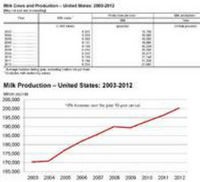The U.S. Dep artment of Agriculture’s National Agricultural Statistics Service will resume milk production quarterly producer surveys in the new federal fiscal year, which begins October 1, 2013. NASS suspended the surveys in April of this year to meet the budget reductions required by sequestration.
artment of Agriculture’s National Agricultural Statistics Service will resume milk production quarterly producer surveys in the new federal fiscal year, which begins October 1, 2013. NASS suspended the surveys in April of this year to meet the budget reductions required by sequestration.
The agency uses information gathered in the quarterly surveys along with various sources of administrative data to establish the monthly milk production estimates. With the quarterly surveys, the dairy cow and milk per cow statistics will once again be available to allow interested parties to forecast future milk supply. The program will resume with a late September mailing of the survey form to producers and the release of resulting data on October 21.
The NASS reports provide important information that is extensively used by both producers and processors in milk markets. The monthly milk production reports have helped provide transparency to the industry, and IDFA expressed concern in April when they were suspended.
IDFA’s legislative team worked with Capitol Hill staff, and Bob Yonkers, IDFA chief economist and member of the USDA Advisory Committee on Agricultural Statistics, contacted the Administrator of NASS to call for a solution. A week later, NASS announced it would continue to publish farm milk production estimates but not estimates of numbers of milk cows and milk output per cow.
“IDFA is very pleased that NASS will resume the quarterly surveys that provide the data necessary for estimates of the number of milk cows and milk output per cow,” said Yonkers. ”This data is very important for market analysts and improves price discovery in our dairy markets at all levels of the supply chain.”
 artment of Agriculture’s National Agricultural Statistics Service will resume milk production quarterly producer surveys in the new federal fiscal year, which begins October 1, 2013. NASS suspended the surveys in April of this year to meet the budget reductions required by sequestration.
artment of Agriculture’s National Agricultural Statistics Service will resume milk production quarterly producer surveys in the new federal fiscal year, which begins October 1, 2013. NASS suspended the surveys in April of this year to meet the budget reductions required by sequestration.The agency uses information gathered in the quarterly surveys along with various sources of administrative data to establish the monthly milk production estimates. With the quarterly surveys, the dairy cow and milk per cow statistics will once again be available to allow interested parties to forecast future milk supply. The program will resume with a late September mailing of the survey form to producers and the release of resulting data on October 21.
The NASS reports provide important information that is extensively used by both producers and processors in milk markets. The monthly milk production reports have helped provide transparency to the industry, and IDFA expressed concern in April when they were suspended.
IDFA’s legislative team worked with Capitol Hill staff, and Bob Yonkers, IDFA chief economist and member of the USDA Advisory Committee on Agricultural Statistics, contacted the Administrator of NASS to call for a solution. A week later, NASS announced it would continue to publish farm milk production estimates but not estimates of numbers of milk cows and milk output per cow.
“IDFA is very pleased that NASS will resume the quarterly surveys that provide the data necessary for estimates of the number of milk cows and milk output per cow,” said Yonkers. ”This data is very important for market analysts and improves price discovery in our dairy markets at all levels of the supply chain.”







